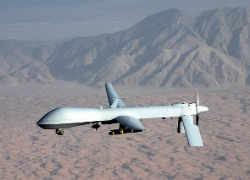Though the news media is seemingly all eyes on the Olympics this week, drones have been making magazine covers and headlines as attacks on militants in Pakistan have escalated during the summer and days before a visit to Washington by Pakistan’s intelligence chief.

(South Asian Tribune)
Drones, also known as unmanned aerial vehicles (UAV), are what their proper name implies: aircraft without a human pilot on board. The machines are either controlled autonomously through computers or under the remote control of a pilot on the ground. Although U.S. drone operations in Pakistan have been ongoing since 2004, drones have become an especially popular tool of the U.S. military during the Obama Administration. This summer in particular has seen a markedly sharp increase in U.S. drone operations in Pakistan. Following the failure to strike a deal to end a six-month blockade on convoys transporting supplies to coalition forces in Afghanistan at the Chicago Nation Summit in May, not a week goes by that there isn’t some report of a drone attack on a militant compound. In July alone, U.S. drone operations killed more than 20 militants.
However, Pakistan has not responded in kind to the attacks. Just days before the most recent strike, Pakistan’s U.S. ambassador officially called for the end of U.S. drone strikes, citing diminishing returns. Instead, Pakistan would like the U.S. to feed intelligence fathered by the drones to Pakistani forces, so that they can target militants.
The turn to drones by the U.S. comes from what U.S. officials perceive as the incapability or unwillingness of Pakistan to target militants; providing shelter to Taliban groups in both Pakistan’s tribal areas and attack troops in nearby Afghanistan. Pakistan’s ambassador called such claims “outrageous,” citing the fact that Pakistan reported 53 times to NATO in recent months when militants were spotted crossing into Afghan territory. Nevertheless, in the wake of these opposing stances as to Pakistan’s fulfillment of its state responsibilities, little is expected to come out of this week’s closed door discussions between head of Pakistan’s ISI spy agency and CIA director David Petraeus.
Beyond the flood of privacy concerns and humanitarian interests drowning much of the discussion on drones in the media, questions of state sovereignty and state responsibility are at the heart of the U.S.-Pakistan drone dispute. On one hand, the U.S. drone operations may be seen as a violation of the sovereignty of Pakistan, what with the U.S. attacking militants on Pakistan’s soil without the consent of the country. Meanwhile, the U.S. claims to be applying drones in the name of self-defense after the failure of Pakistan to uphold its obligations under U.N. General Assembly Resolution 2625 (XXV), which establishes state responsibility to refrain from supporting acts of terrorism. At the same time, the U.S. must still adhere to Article 51 of the U.N. Charter when invoking the right to self-defense under the doctrine of state responsibility. Seeing as the CIA is operating the drone operations, and not a traditional military branch of the U.S. Government, the legitimacy of the U.S. actions are called into question. With Russia and other countries now stockpiling drones, the U.S.-Pakistan drone dispute may very well set precedent for the future of all drone operations.
Cassandra Kirsch is a rising third year law student and a Staff Editor on The View From Above.


